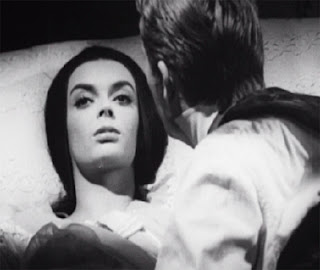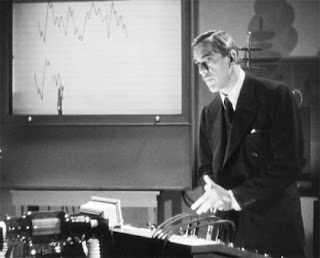Now Playing: Castle of Blood (aka Danza Macabra; 1964)
Pros: Creepy atmosphere in spades; Beautiful black and white photography; Barbara Steele is ethereal and haunting
Cons: Purist Poe fans may object to the way he's depicted in the film
Pros: Creepy atmosphere in spades; Beautiful black and white photography; Barbara Steele is ethereal and haunting
Cons: Purist Poe fans may object to the way he's depicted in the film
I have a nice little morning ritual at work. On the way to the coffee bar in my building for my $1.25 refill, I usually stop at the front desk to chat with my co-worker and fellow sci-fi/horror aficionado Vincent (not his real name). Even with all the blogs I follow and the copious social media interactions, it's nice to talk movies and books in person with someone who shares your interests. Vincent gives me a rundown of everything he's seen since our last talk, and I try to stump him with something he hasn't seen yet (and I usually fail -- in the last year or so, I've only come up with two Netflix instant titles he hadn't heard of).
Our tastes aren't identical. He's much more into the newer stuff, and I'm more appreciative of the old. He's far more tolerant of blood and gore than I am, but he freely admits that he fast forwards through particularly hackneyed and predictable (and egregiously violent) stretches. He's like a grizzled prospector who, after a lifetime searching for gold, seemingly has only the dusty clothes on his back and a mangy old burro with a mean streak to show for it. But he keeps searching, because he knows there's sci-fi/horror gold in them there hills -- and he finds just enough of it to keep going. He is relentless and completely dedicated to his favorite genres.
Vincent also tries to keep up with sci-fi and horror-themed TV shows (at least to watch the first episode or two to see what they're all about). The other day he asked me if I'd seen the premiere of the latest SyFy epic series, Defiance. I don't usually commit to new TV series, even sci-fi and horror, because, well, I've got to have some time left to devote to the classics and this blog. As Vincent was describing the plot, the previews of dozens of recent SyFy and other cable series were dancing around in my head (I may not watch too many series, but I don't live in a cave either, so I do see the ads for a lot of this stuff). Vincent was pretty excited about the new series, but to me it sounded like an everything-and-the-kitchen-sink pastiche of every science fiction series to hit the airwaves in the last several years: Vicious, aggressive aliens whose home world has been destroyed discover Earth and turn off all the electrical power while at the same time unleashing a plague of the walking dead upon humanity; meanwhile, plucky bands of human and alien-human hybrid survivors fight a desperate guerilla war against the cruel invaders. (Or something like that-- it's really hard to tell these shows apart!)
And then there's horror. It looks to me like the angst-ridden teen and twenty-something vampires and werewolves have finally worn out their welcome (knock on wooden stakes). But assorted serial killers, psychos, paranormal investigators, poltergeists, and zombies (herds, hordes, masses, mobs, swarms, multitudes, throngs, and legions of dam**d zombies!) have kicked off their shoes, put their smelly feet up on the coffee table, popped open a foul brew, and taken up permanent residence in theaters, TV, the general popular culture and our collective consciousness. (Just when I'd thought the zombie market couldn't possibly get any more saturated, or that there were any more variations on the theme for callous producers to exploit, along came Warm Bodies, about zombie love. And of course, we can all look forward to World War Z with Brad Pitt this summer. Ugh!)
This stuff isn't scary. Shocking, repellent, nauseating… yes. But really scary? No. You don't need over-the-top shock effects or a bunch of high-end computers dedicated to CGI to raise goosebumps. You can do it with lighting, make-up, sound, in-camera effects, and some imagination. For true fright connoisseurs, there are some subtle, aged vintages down there in the dark cellar, just waiting to be uncorked. The difference between these classics and the current crop of pop horror films and TV shows is like that between a 1949 Lafite-Rothschild and a bottle of MD 20/20. For a domestic (actually Anglo-American) vintage, it's hard to do better than Robert Wise's The Haunting (1963), or almost anything by Val Lewton. For an ethereal, yet complex import with a smoky, supernatural aftertaste, you might want to try Castle of Blood (aka Danse Macabre; 1964).
 |
| Hurry and get your hot dogs, popcorn and soda... only 5 minutes 'til showtime! |
As I recall, the first feature in the double-bill was what looked to be a zero-budget spaghetti western with a small cast and hardly a single word of dialog in the whole thing (for the life of me I can't remember the title). After the initial terror of the mad race to the theater subsided, I remember being mildly curious as to whether either of the principal cast members -- particularly seedy, low-rent versions of the Lone Ranger and Tonto -- were going to say anything. (In hindsight, the producers were brilliant -- they solved the problems with international distribution and language dubbing costs by avoiding dialog altogether. A couple of times over the years I've tried to figure out just what the heck this thing was, with no luck.)
The western was mercifully short, and then it was on to the main attraction. Just a few minutes into the movie, we all got really quiet. None of us had ever seen anything remotely like it. Castle of Blood is a masterful blending of a simple, archetypal story -- a man spends the night in a haunted castle on a bet -- with beautiful, atmospheric black and white photography, sounds that go bump in the night, odd characters in lush costumes who appear out of nowhere, and some wild, unexpected plot twists and turns.
Castle starts out in classic ghost story fashion with a lone traveler wandering into a darkened tavern and encountering an odd, intense man telling a spooky tale to a circle of enrapt listeners. When the storyteller is done, the man introduces himself as Alan Foster (Georges Riviere), a journalist who has traveled a long way to get an interview with the storyteller -- the great Edgar Allan Poe (Silvano Tranquilli). Poe insists that he is not a fiction writer, but rather a journalist like Foster, and that all of his tales are actually true. When Poe matter-of-factly states that the tomb or the grave is not always the end, and that many "live" beyond death, Foster insists the writer is having fun with him. Foster is a rationalist who has a hard time believing any intelligent person can believe in ghosts or the hereafter.
 |
| The fateful bet is made. (From the left: Silvano Tranquilli as Poe, Georges Riviere as Foster and Umberto Raho as Lord Blackwood) |
A third man who has been listening to the two debate introduces himself as Lord Thomas Blackwood (Umberto Raho), and he gets right down to business, betting the skeptical journalist 100 pounds sterling that he can't spend a single night in his haunted castle out in the country.
Foster: Why, do you believe I might run away from the place?At first demurring, the insouciant Foster informs Blackwood that journalists of his ilk are poorly paid, so he can only afford to bet a measly 10 pounds. Blackwood gleefully takes him up on it. They pile into Blackwood's carriage to make the long ride to the castle-- the aristocrat wants to get Foster there by midnight on the "Night of the Dead," a time when "the dead come back to perform again those tragedies which have cost them their lives…" Okaaaayyyy then.
Blackwood: No, you'd remain there. Of all those who've agreed to take up my wager, not one has ever lived to run away.
And perform they do! While at first the castle is deathly quiet, soon Foster hears harpsichord music and sees a dancing couple that, upon further investigation, aren't there. He feels a hand on his shoulder, and whirling around, is startled to see an alluring dark beauty dressed in white (Barbara Steele). She introduces herself as Elisabeth Blackwood, Thomas' sister and the sole remaining occupant of the castle. Foster is confused, as Lord Blackwood hadn't mentioned any residents, but also relieved to have such beautiful company.
 |
| "My heart isn't beating. It hasn't beaten for 10 years. I'm dead Alan." |
Castle of Blood came fairly early in director Antonio Margheriti's (aka Anthony M. Dawson's) long career. His work as a model-maker and documentary film assistant in the 1950s caught the eye of a producer who wanted to capitalize on the late '50s science fiction craze, and Assignment: Outer Space (aka Space Men; 1960) launched him into orbit as a director (see Louis Paul, Italian Horror Film Directors, McFarland, 2005). Margheriti has done it all: horror, sci-fi, sword and sandal, spies, war, westerns, even a martial arts western… but Castle of Blood remains his masterpiece. According to Lawrence McCallum (Italian Horror Films of the 1960s, McFarland, 1998), Castle/Danza Macabra was shot in 1962, possibly in response to the popularity of Mario Bava's Black Sunday (1960) and Roger Corman's early Poe pictures, but it wasn't released in the U.S. until 1964, and then, on the bottom of a double-bill with Hercules in the Haunted World (1961). Years later, Margheriti remade Castle, adding color and the talents of such actors as Anthony Franciosa and Klaus Kinski, but the critical consensus is that Web of the Spider (1971) is a pale imitation of the original.
 |
| "Come, I've prepared your room upstairs." |
If you've browsed around this site any, you may have stumbled on the list of my all-time favorite horror and science fiction films -- Castle of Blood is on it. It's one of a handful of films that I vividly recall seeing for the first time. With its masterful black and white photography (courtesy of Riccardo Pallottini) and cast of weird characters headed by the enigmatic Steele, Castle of Blood is surprising, surreal and unsettling. It's a modest B masterpiece that, better than almost any other horror film that I can think of, burns its uncanny images in the unwary viewer's brain, leaving him queasy and uneasy. Go ahead, press play late at night, with the lights turned low. I dare you.
Where to find it:
Oldies.com
Amazon Instant Video
"Here the dead rise from their tombs once a year to repeat their hideous crimes of murder and passion!"














